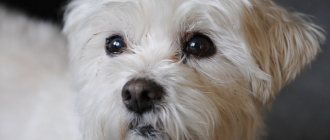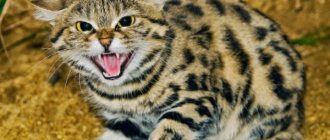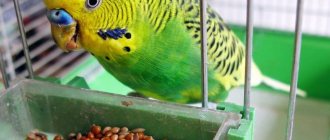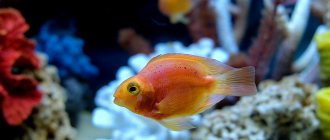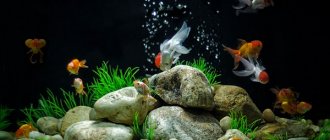When choosing a budgie, we are faced with such a wide range of different colors that we can get confused. The color of these unusual bright birds is striking in its variety of shades and richness.
In the wild, the “natural” color of a budgerigar is light green.
Photos of green budgies:
Since both the male and female budgerigar have the same color genes, the chick turns out to be similar to its parents. Of course, in nature there are also deviations from the standard colors - this is explained by the receipt of different hereditary characteristics from the couple. As a rule, such a bird does not survive: the color of its plumage is a signal for predators and does not save in an emergency situation, and a flock of parrots can kill “not like everyone else.” Nature thus selects the most adaptable hereditary traits, thanks to which the bird has a chance to survive in the wild.
Domestic budgies owe their color diversity to humans. They feel great under appropriate conditions. Different plumage colors do not in any way affect their quality of life and relationships between relatives.
Photo: Rachel Kramer
A Brief History of the Color Genetics of Budgerigars
Through long-term selection, at present, in the colors of budgerigars, there are about 32 primary mutations, which in turn give more than a hundred secondary ones. It took scientists many years so that today we can enjoy the incredible variety of colors of budgerigars. Thanks to the laws of inheritance, breeding a particular color now becomes possible even for ordinary bird lovers.
In 1872, as a result of long work, breeders managed to breed a yellow budgerigar. And only in 1878. Belgian scientists introduced the blue budgerigar to the world, but offspring of this color were obtained only in 1910.
Photo of a blue budgerigar:
Thanks to the blue wavy, dark blue and dark green parrots were born.
Photo of a white budgie:
White budgerigars were bred in France in 1917, and 7 years later albinos appeared in Germany, and parrots of variegated colors appeared in Denmark. We owe the purple and brown colors to England.
April 1, 1994 The World Budgerigar Breeders Organization (WBO) was created, which prescribed standards used both at exhibitions and in everyday life to guide the genetic colors of budgerigars.
Hyacinth macaw
Macaws are deservedly popular among fans of ornamental birds. These are very smart, quick-witted pets that can compete with dogs in intelligence and devotion. In addition, they are distinguished by their bright plumage. The most beautiful of this species of parrots is the hyacinth macaw with a stunningly intense indigo plumage. A few facts about this bird:
- this is a very large parrot - its size, including its long tail, reaches a meter;
- weight about one and a half kilograms - males are larger, females are smaller;
- in nature, birds live in Bolivia, Paraguay and Brazil;
- They live in captivity up to 60 years, in the wild they live less - about forty.
The price of a hyacinth macaw chick starts from ten thousand dollars. The maximum price in nurseries that specifically breed stunningly beautiful birds with an intense blue color can reach thirty thousand.
WHOVP Standards
We will look only superficially at the classification of wavy colors, since this is a whole science and for a more in-depth study it may take much more time. A person who has never delved into the genetic characteristics of colors until now may simply get confused in the variety of groups and subgroups of budgerigar colors.
| Groups of budgies | Photo of the group representative |
| Normal green budgerigars | |
| Opaline budgies green and blue row |
|
| Cinnamon budgies of the green and blue row | |
| Opaline cinnamon (Opaline Cinnamon) green and blue budgerigars | |
| Lutino and albino (Lutino, Albino) | |
| Clearwings Yellowwings and Whitewings |
|
| Crested variety | |
| Spangle (Spangle) budgies of the green and blue row | |
| |
| Yellowface |
|
| Greywing budgerigars of the green and blue series |
|
| Fallow budgies of the green and blue row | |
| (Clearbody) budgerigars of the green and blue row | |
| (Saddleback) budgerigars of the green and blue row |
There are “Normal” colors and patterns. Scientists decided to call the light green color of the first parrots imported to Europe Normal color The normal pattern of a parrot is the standard black waves that accompany the original appearance of budgerigars.
The group of Normal green budgerigars includes: Light Green, Dark Green, Olive Green, Greygreen, Skyblue, Cobalt, Lilac (Mauve), Violet (Violet), Gray (Grey).
Kakapo
Representatives of this species are rare in the world; the total number of representatives is about two hundred. The feathers are colored green, and near the beak they are gray. Birds very rarely fly; they prefer to move on their powerful legs, while allowing few people to approach them. Rarely purchased as pets, they are usually purchased by scientists who want to protect parrots from extinction.
The kakapo is native to New Zealand. It is extremely difficult to buy a young individual; to implement your plan you will have to set aside about ten thousand dollars. Birds are quite finicky and require care. They are rarely found as pets, primarily not because of the high cost, but because of their habit of making loud noise at night.
Future color of the offspring of budgerigars
In order to at least slightly predict the color options of the chicks from your pair, you need to determine what the main color of your wavy is.
Green parrots have a natural base color of yellow. Blue parrots have white.
There is also a Parblue species between the Green and Blue rows of parrots - these are the Yellow-faced and Golden-faced parrots.
The color of green budgies is dominant during breeding.
Parblues are dominant to Blue parrots, but recessive to Green parrots.
Blue budgies are recessive to other colors.
Interestingly, the part of the spectrum in which parrots see each other is ultraviolet and their colors are much brighter than a person can see. Moreover, if you look through the eyes of a parrot at another budgerigar, you can see that the radiance of the bird is provided not only by the color of the plumage, but also by the wax and paws, which are cast in an azure color. The budgerigar's cap also attracts the eye with its unusual shine.
During mating and courtship, birds try to show themselves in all their glory. The brightness of the male's plumage plays a decisive role for the female.
Blue Macaw
Completely extinct from the wild and truly the most expensive parrot in the world. Offers to buy a chick start at $50,000 and above. Requires complex care and special conditions. The blue macaw can be recognized by its beautiful plumage ranging from light bluish to cobalt.
The birds once lived in nature, but due to huge demand on the black market, they were completely destroyed by poachers. There are only a few nurseries in the world where these birds are bred. Blue macaws are small - approximately 50 cm and up to 400 grams with a long tail.
Large parrots - cockatoos, macaws, grays - are not cheap in any case, but they will cost much less than these unique species. Like any exotic birds, each of them requires special handling, difficult conditions and delicate care. Of course, those who can afford to spend thousands of dollars on a bird provide their pets with an appropriate “standard of living.”
Rare colors of budgies
The best chance to get acquainted with the rare colors of budgerigars is to visit a large bird exhibition. But don’t be upset: some breeders also encounter unexpected color mutations in the plumage of budgerigars.
| Name of the color of budgerigars | Photos of birds |
| Rainbow | |
| Saddleback | |
| Anthracite |
|
| Crested | |
| Slaty | |
| Texas Clearbody | |
| Lacewing | |
| Variegated |
The following table shows budgerigars with color and wave pattern mutations that are not included in the WHOV list:
| Name of the color of budgerigars | Photos of birds |
| (Blackface) | |
| (Half-Sider) | |
| Mottled | |
| |
| Misty | |
| Brownwings - very similar to Cinnamon, except for the dull color of the plumage | |
| Faded |
People will continue to admire budgies for centuries to come, prompting ornithologists to study their habits and lifestyle in more detail. Thanks to parrots, scientists are adding the bright colors of these magnificent creatures to the human world.
~Parrots Online~
:rainbow: :two_hearts: []I wish you good health, friends! As a full-fledged member of this co-op, I decided to launch my own section, I hope you like it.
The rarest TYPES and COLORS of parrots.
I'll start with one of the rarest parrots in the world! This species has disappeared in the wild, but exists among some parrot collectors.
This handsome blue macaw (lat.Cyanopsitta spixii) the body length of this bird is 55-57 cm, weight is about 400 g. It has a yellowish iris, a black beak, the handsome head is light gray, and the color of the plumage itself is faded blue. The chest and belly are sea green. The wings and tail of the macaw are dark blue. The ears and forehead are slightly lighter than the main color of the head.
Chicks
As you can see, young individuals have a light “stripe” in the middle of the beak; by the time of puberty, this stripe disappears. In chicks, the unfeathered areas are lighter than in adults. The chicks also have a completely black eye, without a yellowish iris.
Attempts to save the species. Population of the species at a given hour.
The last blue macaws people saw in the wild lived in the Brazilian state of Bahia. In 1985-1986, only three birds remained there; in the following years they were caught to be sold. One male blue macaw lived in this area with a female parrot of another species from 1990 to the end of 2000, but nothing is known about him after this time.
There is no further information about these birds in the wild, despite constant searches and observations. In 2021, a video emerged of a blue macaw flying between trees in the state of Bahia. However, experts believe that this bird did not live in the wild, but was released from captivity.
“Human activity is the primary cause of almost all recent species extinctions,” Stuart Bouchard, chief scientist at BirdLife International and lead author of the paper, told IFLScience. — The rate of extinction on the continents is now higher than ever before. And it will continue to grow without concerted conservation efforts.”
Blue macaws are birds of the parrot family. In the wild, they lived only in Brazil between the Parnaiba and Sao Francisco rivers. Now they can only be seen in zoos and breeders. Blue macaws became famous after the release of the cartoon "Rio" in 2011. In the story, the last wild male and female are kidnapped by smugglers involved in the illegal export of rare species of birds. Most likely, at the time of the premiere of the cartoon, there were no more blue macaws left in the wild.
Source 42TUT.BY
In the wild, the last male disappeared in 2000, the cause of the disappearance was: mass catching of birds by people, African bees.
In 2004, in Loro Parque, they managed to get a chick from a pair of such birds and raise it safely.
According to 2007 data, there were 90 birds in private collections.
According to 2010 data, there were 105 birds in private collections.
According to 2014 data, ornithologists are managing to save the species, but slowly. Approximately 500-400 birds.
Source Wikipedia.org
:rainbow: :two_hearts: []I hope this article was informative, thanks for reading!
11 :+1: -continued.
Corella (nymph)
The small graceful Australian nymph parrot, or cockatiel, is perhaps the best choice for a beginning birder who dreams of a “talking” pet. It is small in size, inexpensive, fairly unpretentious in content and is quite capable of imitating human speech.
Corella is the closest relative of the cockatoo. This bird naturally lives in flocks in the savannah, and appears in European homes only in the middle of the 19th century and immediately gains great popularity. Moreover, as in the case of the previous parrot, breeders tried to develop many of its colored decorative forms.
With adequate training at home, the cockatiel is quickly tamed and can memorize 100-150 words, as well as simple melodies. Males sing well, imitating street birds - nightingales, tits, magpies. If you are not able to devote a lot of time to the nymph, be sure to buy her relatives for company - otherwise this parrot will quickly get bored and wither away, as it is highly susceptible to stress and mood swings.
Moluccan cockatoo
The Moluccan cockatoo is endemic to Indonesia. Currently, there are no more than 10,000 representatives of this species in nature. The body length of the Moluccan cockatoo is about 40 cm, weight is 850 g. The plumage is pale pink, lush. On the head there is a crest up to 15 cm long, formed by orange-red and pinkish-white feathers. Life expectancy is 40-80 years, the cost of a chick is about 250 thousand rubles.
The Moluccan cockatoo is well tamed, but it becomes attached to only one owner, perceiving other people with wariness. If there is a lack of attention, the bird becomes stressed and plucks its own feathers.
Eclectus
The bright exotic eclectus (lat. Eclectus roratus) is large in size - 29–37 cm in height. This is a capable parrot, easy to train, but taciturn . His advantage is that he is flexible in everyday life, has an even character, and is never aggressive. It is also often called the noble parrot.
Males, as a rule, have green-blue plumage, females - red. The beak of both sexes is large and shiny. In males it is yellow or red. In females it is black. Their wings are long and their tail is square. In general, the body is well developed and strong.
Unlike other breeds of parrots, these birds are not monogamous.
The habitat is quite wide - eclectus can be found on many islands: the Moluccas, Salamon, Tanimbar, as well as in Australia and New Guinea.
The parrot easily gets used to home conditions. He becomes so attached to a person that he can even pay more attention to him than to his partner. He is affectionate, loves attention and communication. He has an extraordinary mind and intelligence. Girls are more difficult to make contact with, and they are also not as easy to tame as males. The love of a female will need to be earned. These parrots rarely scream.
In addition to a few words, eclectus can also learn cleanliness, for example, returning food that has fallen from a plate or putting small toys in a box.
The lifespan of eclectus is 30-40 years.
The cost for adults is $500.
Did you know? Parrots do not have vocal cords. They imitate speech using their tongue and beak.
.


